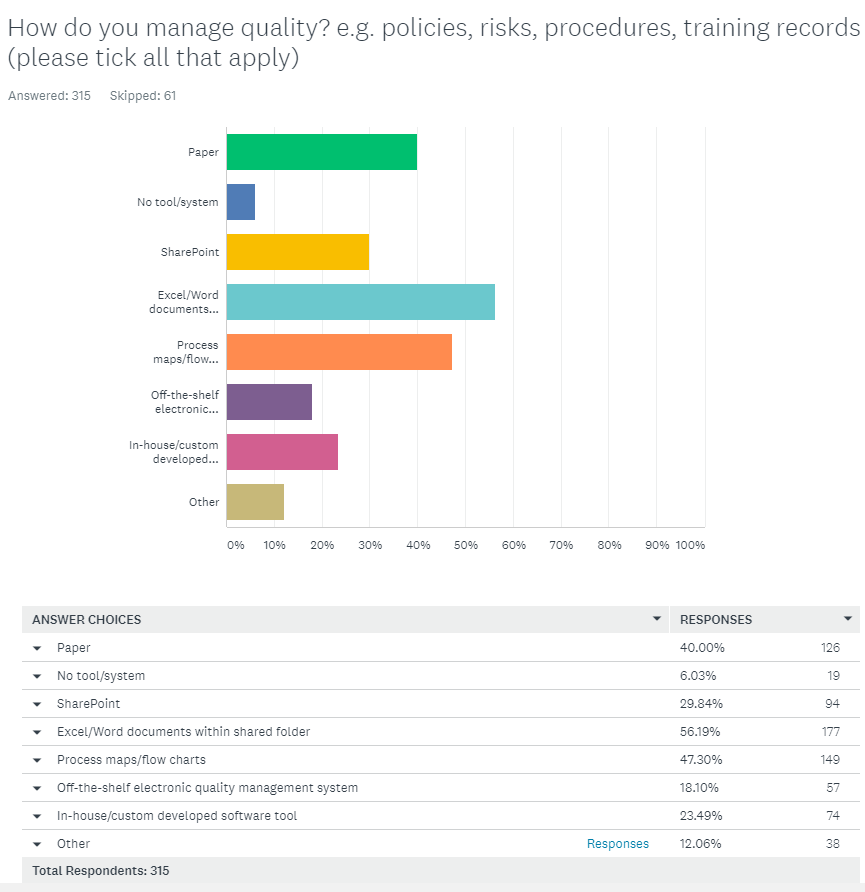Want to contribute to this article?
.jpg?width=640&name=Desk%20clutter%20(image%20credit%20-%20Alamy).jpg)
Picture the scene.
Multiple spreadsheets open on your screen. Scribbled Post-Its – "non-conformity doubled", "increase in outdated documents" – stuck haphazardly around your desk. Piles of paper with last week's to-do lists.
If this sounds familiar, you aren't alone! Over half of the quality professionals who responded to the Global Quality Survey 2017 said they spent at least a full week of every month compiling and producing reports.
While Big Data has created an explosion of opportunities for you to reinvent the role of quality, paralysis by analysis is slowly stealing your precious time and sanity.
But it's difficult to avoid the overload. There's now so much data, it can be incredibly overwhelming. So where should you be focusing your efforts?
Below, we have set out three essential key performance indicators and ways in which you can quickly get and measure this data. These metrics were recommended by 151 quality professionals in the Global Quality Survey 2017. You might also find the following articles useful:
3 tips for choosing KPIs
5 quality performance indicators you should be tracking
#1 – Customer complaints
It's more than 100 years since the catchphrase "The customer is always right" was popularised by retailers such as Harry Gordon Selfridge, but it's still an essential motto for every business, and the not-so-secret key to long-lasting success.
Quality is driven by customer demand: a good and consistent product or service must be deemed a quality experience. That's why customer complaints come so high on the list of common KPIs: lots of complaints leads to a reduction in quality.

Measuring customer complaints is complex and so is likely to be one of your most time-consuming tasks. Some factors you might encounter in your measurement include:
- Number of complaints in a set time period
- External factors to consider in the number of complaints (poor weather affecting delivery, for example)
- Where the complaint originated (service, product, delivery, aftercare etc.) and the individuals linked to that complaint
- How many complaints were solved immediately or had to be escalated
- Time taken to resolve a complaint
- Complaints dealt with outside internal SLA closing times
- Type of action taken (refund, return, replacement, future discount etc.)
- Result of corrective action (escalation, closure, customer NPS score).
#2 – Preparing for and reporting on audits
Audits are commonplace for any quality professional. But one problem they face all too often is the need to devote time to correcting potential non-conformities before their audits have even begun.
Those professionals who used systems such as EQMS Audit Manager spent considerably less time preparing for and reporting on audits. However, the principle remains the same: audits are crucial to ensuring continuous quality improvement.
"70% of those who responded to the survey agreed that 'being ready for external audits' is important or extremely important to their role and organisation."
Internal audits were found to be a key metric, whether carried out as standard for continuous quality, or before planned external audits to prevent non-conformities from being raised.
Quality professionals who used audit tools such as EQMS Audit Manager reported less stress on their workload overall, highlighting technology as essential to success in an integrated quality culture. Automated reports and on-the-go audit options reduced the time spent collating information and findings, and allowed internal auditors to carry out audits on-site without the need to duplicate any effort.
#3 – Reviewing, uploading and changing documents
Quality professionals who are, or want to become, ISO 9001:2015 certified highlighted the importance of reporting on document-related issues within their organisation.
Problems such as outstanding feedback and outdated documents affect quality at a broader level. Reporting on these problems helps you to find the sticking points in the feedback process, identify areas in which you can further streamline automated workflows, and highlight usage metrics the quality management system provides.

Organisations that are ISO 9001:2015 certified have found that, despite having a quality management system in place, the number of employees actually using that system can remain low (for example, managers with administrator capabilities leaving out-of-date documents on the site). This can lead to further problems (such as incorrect customer instructions being followed), resulting in a flawed product which does not meet requirements. The costs involved in rectifying such flaws are limitless, so by using documentation review as a KPI you will be able to stay ahead of potential problems.
What you should do now
For more information about the Global Quality Survey, download the report here.
Or, for more information about using EQMS to bring together all your quality performance indicators, request a free demonstration here.
Photo credit: Alamy









Share your thoughts on this article